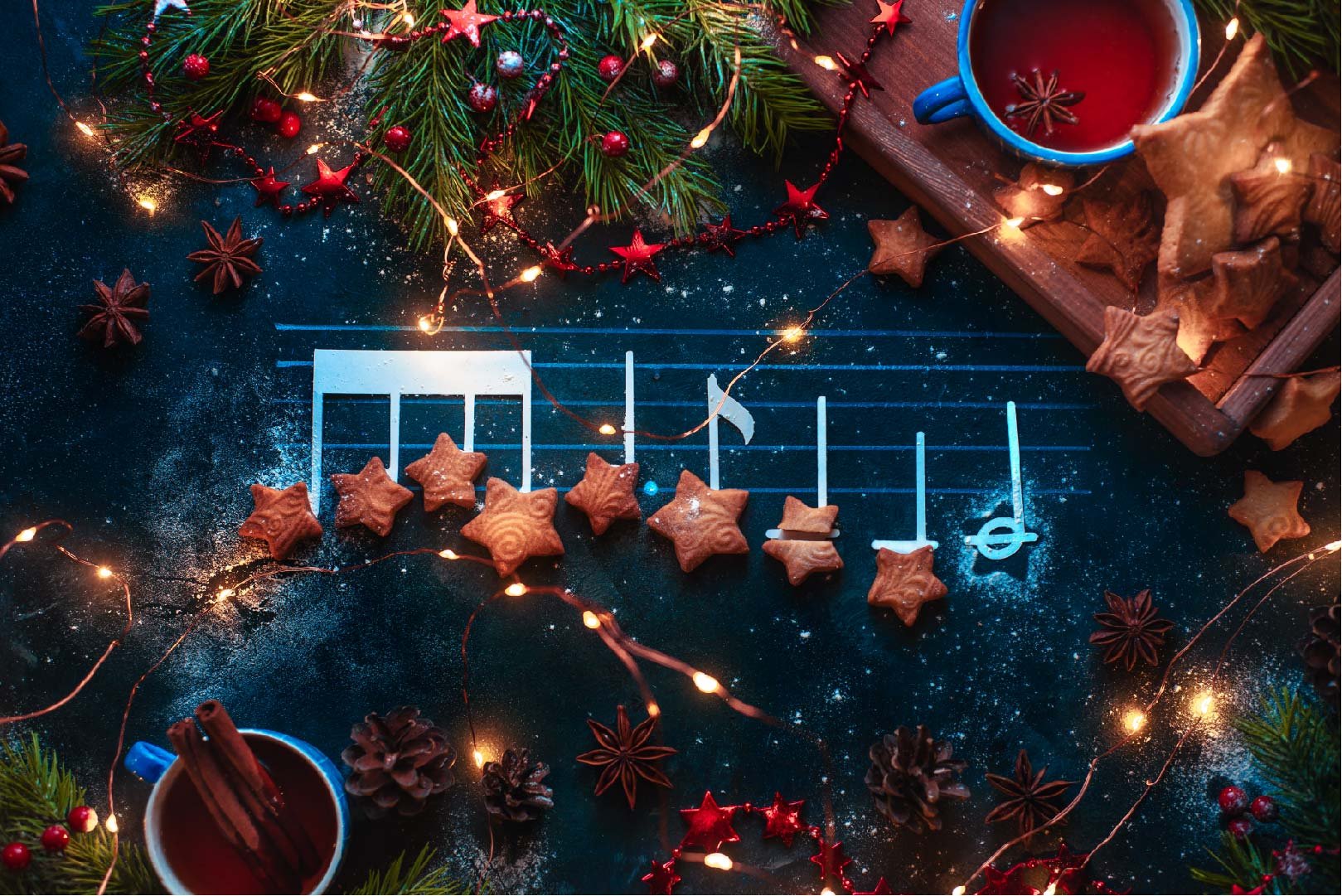
TLDR; Rabinovitz provided a neurological explanation for why we like covers: They meet our expectations.
You should still scroll through the article and see just how many songs are from the 20th century!
For a few weeks every winter, popular music tumbles into a time warp.
Unless you have peers who start their Christmas season immediately after Halloween…
Old-school trumps cutting edge. Greatest Generation artists rule millennial playlists. A 27-year-old song leads the pop charts — and it’s considered a “new” entry into the Christmas canon.
Twenty songs have ruled Billboard’s Holiday 100 since the list began in 2011, and two-thirds of them were written before 1980.
These are the top 20 holiday songs according to Billboard.
These songs have dominated Billboard’s Holiday 100 list since 2011. We took the top 20 songs of each week and scored them by their weekly rankings. The list below is sorted by the best-performing songs on Billboard’s list, which covers the December and January weeks each year.
- All I Want for Christmas Is You | Mariah Carey, 1994
- Rockin’ Around the Christmas Tree | Brenda Lee, 1958
- Jingle Bell Rock | Bobby Helms, 1957
- The Christmas Song (Merry Christmas to You) | Nat King Cole, 1946
- A Holly Jolly Christmas | Burl Ives, 1965
- It’s the Most Wonderful Time of the Year | Andy Williams, 1963
- Feliz Navidad | José Feliciano, 1970
- Last Christmas | Wham!, 1984
- White Christmas | Bing Crosby, 1942
- Rudolph the Red-Nosed Reindeer | Gene Autry, 1949
- Let it Snow, Let it Snow, Let it Snow | Dean Martin, 1959
- Christmas Eve (Sarajevo 12/24) | Trans-Siberian Orchestra, 1998
- It’s Beginning to Look a Lot Like Christmas | Michael Bublé, 2011
- Sleigh Ride | The Ronettes, 1963
- Mary, Did You Know? | Pentatonix, 2014
- Happy Xmas (War Is Over) | John & Yoko/The Plastic Ono Band With The Harlem Community Choir, 1971
- Blue Christmas | Elvis Presley, 1957
- Hallelujah | Pentatonix, 2016
- Wonderful Christmastime | Paul McCartney, 1979
- Christmas Canon | Trans-Siberian Orchestra, 1996
Even Grinches get warm fuzzies from old holiday songs.
What is going on here? The answer is nostalgia, said literally every person contacted for this story.
“Generally, popular music is about putting yourself out there, new relationships, new beginnings, being young and single and dancing,” said Joe Bennett, professor of musicology at Berklee College of Music. “Christmas music is almost the reverse of that, conceptually and lyrically. It is about homecoming, nostalgia, looking back to a more innocent time in one’s life or cultural history.”
We could argue nonstop about what constitutes the holiday canon, but the top of the top is pretty clear — and pretty old. Most were written in the 1970s and earlier, and many of the most popular versions of those songs were released that long ago as well.
Only three of the most popular 20 holiday songs were released this century, and all are covers of much older songs.
Pentatonix’s cover of “Hallelujah” is the newest song on the list, having been released in 2016.
The oldest song on this list, Bing Crosby’s “White Christmas,” was released in 1942.
Holiday music burrows into a sweet spot in our brains’ wiring, said Brian Rabinovitz, a lecturer at the College of William & Mary whose expertise is the neuroscience of music.
All music can stimulate the brain’s pleasure centers, he said, but holiday music can evoke treasured memories on top of that, courtesy of the brain’s filing system. Tonal patterns and autobiographical events are processed in overlapping regions of the medial prefrontal cortex.
That means that even though you might be into avant-garde jazz, death metal or emo, the rest of the year, you may involuntarily turn to mush when you hear “White Christmas” because your brain associates that song with baking cookies in grandma’s kitchen when you were 6.

So how does a new song break in?
“For obvious reasons, it’s a real challenge to add something new to that canon,” said Mark Simos, Bennett’s colleague and a professor of songwriting at Berklee, in an email, “because it’s by intention not a contemporary style — and because those songs carry lots of specific cultural associations for listeners.”
But getting into that rare air is hugely profitable, so artists keep trying, and every decade or so, someone succeeds.
John Lennon and Yoko Ono did it with their 1971 duet “Happy Xmas (War Is Over).” So did Paul McCartney’s 1979 song “Wonderful Christmastime” and Wham!’s “Last Christmas,” which debuted in 1984.
And sitting pretty in a red elf suit atop them all is Mariah Carey’s 1994 blockbuster, “All I Want for Christmas Is You” (AIWFCIY for short).
“It’s almost like buying a lottery ticket and burying it in the backyard,” said Post music critic Chris Richards. “If your song ends up striking gold, you end up in heavy rotation every December until the end of time.”
Songs that make the top of the list tend to have certain similarities.
They usually have short, repetitive lyrics and standard holiday themes. They don’t even really have to make a lot of sense. Mel Tormé’s “A Christmas Song” is just a litany of images: chestnuts roasting, Jack Frost nipping, carolers, mistletoe, yadda yadda yadda. And we love it.
Bennett analyzed the lyrics of U.K. Spotify’s top 200 streams from Christmas week in 2016 and found 78 were holiday songs, most of which also show up on U.S. lists. The lyrics of those 78 fell into at least one — and often more — of eight thematic buckets. (He put an instrumental in a ninth category.)
Holiday song lyrics share a few common themes.
Mariah Carey’s “All I Want for Christmas Is You” includes multiple lyric themes found in the most popular holiday songs.
- Home (14 songs)
- Santa (14 songs)
- In love (12 songs)
- Snow (12 songs)
- Lost love (9 songs)
- Party (7 songs)
- Peace on Earth (5 songs)
- Religious (4 songs)
- Instrumental (1 song)
Source: Data based on Joe Bennett’s analysis of top 200 U.K. Spotify song streams from the week of Dec. 25, 2016. Most of these songs overlap with the same set as seen on Billboard’s Holiday 100 lists.
Nearly all of the songs Bennett analyzed were in a major key, and 90 percent were 4/4 time, the most danceable time signature (4 beats to a measure, quarter-note gets a beat). They averaged a tempo of 115 beats per minute — “not frenetic,” Bennett said, “but it’ll get you a little bit of cardio.” (AIWFCIY is 150 bpm, one of the fastest holiday songs.)
Subtlety is not a requirement. Nearly half featured audible sleigh bells.
Both Richards and Bennett cited Ariana Grande’s 2014 song “Santa Tell Me” as one that might someday claw its way to canon status, and Bennett mentioned Leona Lewis’s “One More Sleep” as well. Both share certain characteristics with Carey’s hit, but neither is a sure thing.
The deal with covers (a.k.a. your brain on Michael Bublé)
Of the 20 songs that dominate Billboard’s list, many are covers. Because we are enamored with the old stuff, it’s not surprising that the canon is littered with newer versions of classics.
One of the most recent is by the current king of holiday covers, Canadian crooner Michael Bublé, whose 2011 album “Christmas” provided 10 of the songs in Bennett’s 78. What the album lacks in original songs and title creativity it makes up for in production values, Bennett said.
“He’s choosing very old songs played with classic old school, big-band arrangements, but he’s recording them with contemporary technology that makes them radio air-play friendly,” Bennet said. That way, people can “have all of the sound quality they expect in a modern recording from a contemporary artist while getting all the nostalgic feelings that we want from the songwriter.”
Rabinovitz provided a neurological explanation for why we like covers: They meet our expectations.
Our brains feel rewarded when they correctly predict what happens next, and if a prediction is wrong, we feel momentarily discombobulated. But if the surprise is not too drastic, he said, our brains might decide they like the change — and then they are often happier than if there had been no surprise in the first place. It’s why many of us like surprise parties and roller coasters even though they’re initially terrifying.
It works the same with music, Rabinovitz said. “You can have your prediction violated but find it wonderful.”
This is why cover artists tinker a little but don’t usually stray wildly from the original arrangements.
For instance, from the first raspy syllables of Bruce Springsteen’s 1975 version of “Santa Claus Is Comin’ to Town,” you know you’re not hearing Fred Astaire’s version from the 1970 TV show, which was itself one of many covers of the 1934 song. The timing between words is different; some notes stay down when your brain thinks they should go up. But you also hear those sleigh bells and you know those words, and well, your brain decides that the Boss’s version is pretty darn good after all.
The original “Have Yourself a Merry Little Christmas” was recorded by Judy Garland in 1944. That version appears in the Holiday 100 along with eight different covers from 2011-2019.

Hippos, donkeys, menorahs, and death by… reindeer?
Just like there is a canon for traditional holiday songs, there’s a canon of sorts for novelty songs, which are too goofball-niche to enter the Serious Traditional Canon but are also too much fun to not play every year.
Rather than aiming for universality, novelty songs address a specific theme or appeal to a certain slice of people. The genre is not new — it developed right alongside the canon during the creative exploration of songwriters in the 1950s, Simos said.
For example, “I Want a Hippopotamus for Christmas,” recorded in a startlingly Ethel-Merman-like voice by 10-year-old Gayla Peevey in 1953, has a clever conceit: a child making an unreasonable demand.
“It gives you that charming feeling of what a nice idea,” said Bennett, “but it’s not a universal sentiment.”
New York-area earworm “Dominick the Donkey,” recorded by Lou Monte in 1960, is sprinkled with Italian vocabulary and tells the story of a donkey that delivers Brooklyn-made presents to kids in Italian hills too steep for reindeer. It’s a hoot, but a little of the chorus’s “ee-HAW, ee-HAW” goes a long way.
Elmo & Patsy’s 1979 tale of a Christmas Eve tragedy, “Grandma Got Run Over by a Reindeer,” is a bit too twisted to jibe with many people’s idea of the Christmas spirit.
Adam Sandler’s “The Chanukah Song” (1994, plus three updates) offers up a litany of famous Jews, a few PG-rated lyrics and some pretty great rhymes — “marijuanica,” “gin and tonica,” “Tijuanica” — and requires a certain sense of humor (a working knowledge of Hanukkah tradition helps, too).
Ah, but once in a while, a supposed “novelty song” turns out to be universal after all.
José Feliciano feared his 1970 cultural mashup “Feliz Navidad” would never get U.S. airplay, but the ridiculously simple song — six words in Spanish and 14 in English, set to a Latin beat — is now among the most popular holiday songs of all time. Its entire message: I want to wish you a Merry Christmas.
The vanilla theme, the peppy beat, the endless repetition and the easy-to-remember lyrics make a powerful combination — and it doesn’t hurt that the triangle and maracas together sound a lot like sleigh bells.

These are the voices you’ll hear the most.
These artists have had the most songs appear at least once on Billboard’s Holiday 100. The a cappella group Pentatonix has had 16 songs appear, one more even than Bublé. Below is how each artist’s top songs ranked over time.
Pentatonix | 16 songs, with their top 3:
- “Hallelujah”
- “Little Drummer Boy”
- “Mary, Did You Know?”
Michael Bublé | 15 songs, with his top 3:
- “It’s Beginning to Look a Lot Like Christmas”
- “All I Want For Christmas Is You”
- “Have Yourself a Merry Little Christmas”
Bing Crosby | 10 songs, with his top 3:
- “White Christmas”
- “It’s Beginning to Look a Lot Like Christmas”
- “Adeste Fidelis (Oh, Come All Ye Faithful)”
Frank Sinatra | 8 songs, with his top 3:
- “Jingle Bells”
- “Have Yourself a Merry Little Christmas”
- “Let It Snow! Let It Snow! Let It Snow!”
Andy Williams | 8 songs, with his top 2:
- “It’s the Most Wonderful Time of the Year”
- “Happy Holiday/Holiday Season”
Ariana Grande | 7 songs, with her top 2:
- “Santa Tell Me”
- “Last Christmas”
Note: Songs included appeared at least once on Billboard’s Top 100 Holiday list, from 2011 to 2019.
Who we are
The Live Learn Innovate Foundation is a 501(c)3 nonprofit entity that empowers software users to regain control of their personally generated health data, gain intuitive insights about their social data, learn the impact of their environment on health, and build a foundation of data analytics that empowers research, academics, and innovation in economic development. Use cases for this secure, private method of data aggregation appear everywhere, expanding to family care, community growth, agricultural planning, and many more things still unseen. Help us keep going by getting involved today.